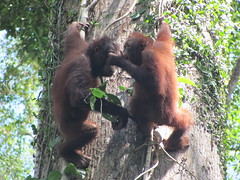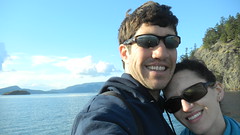While still on Borneo, we heard lots of good things about Sepilock. This is a town that’s barely on the map except for its conservation efforts. Lots of our fellow travelers recommended we stop by, so on our way to Vietnam (by way of Kuala Lumpur) we made the side trip to Sepilock. This was about a six-hour trip by boat and bus to get from Uncle Chang’s to our new home, Paganakan Dii.
It was during the five-hour bus trip that I began to understand the need for an orang utan rehabilitation center. For several years I’ve been hearing about deforestation in Southeast Asia, and avoid foods containing palm oil in my own quiet way of protesting. But never could I have understood the scope of palm oil monoculture until taking this trip across Sabah.
For nearly all of the five hours, while Malaysia’s answer to MTV (back when they played *music*) blared on the bus’s television, we passed mile after mile after mile of palm plantations. Why is this a problem? Well, for lots of reasons, and many that are far beyond my scope of understanding. But one thing I can wrap my head around is this: when you plow down thousands of miles of forests to plant a single crop, entire ecosystems are displaced and/or destroyed. I’m not even smart enough to broach the environmental issues that directly impact all of us; but I do know that these peatlands, when plowed, emit powerful greenhouse gases that contribute tremendous carbon emissions.
Ok, Debbie Downer, back to the monkeys. Sepilock Orang Utan Rehabilitation Center is the go-to place to help return displaced, orphaned, or illegally-kept pet orang utans back to the wild. When they receive one of these animals, they’re seen by the staff vet and quarantined until their threat of spreading disease has passed. Depending on their wilderness-readiness stage, the animals then are either placed in a nursery or skip this part and go to Outward Bound School. Some orang utans might have been taken from their mothers before developing survival skills; if so, the skills are taught by staff. Can you imagine a human teaching a monkey how to swing from the trees and forage for food?
In several phases and over sometimes several years, orang utans are weaned back into the wild. This step-by-step process ensures they become less dependent on their human helpers and gradually grow self-sufficient. Finally, after they are deemed ready, orang utans graduate to the jungle. The center at Sepilock is one of only about four in the world.
Over one hundred orang utans have been rehabilitated here through this process. We were able to pop in for feeding time, which allowed us to watch a few early-stage orang utan trainees receive their brunch: vitamin/mineral enriched and fortified milk, and a few bananas.

Where do I go next?

I think we should go that way...
These guys were still pretty small, but you wouldn’t believe their strength and flexibility. Their primary method of transportation is swinging by their unbelievably powerful arms. An adult male orang utan is four times stronger than an average adult human male! The males can weigh between 110-300 pounds, while the females tip the scales at around 60-110 pounds. Orang utan means “man of the forest” and the forest is definitely where they were designed to live. Getting close to some of them, it was striking how incredibly human-like they are… or perhaps how orang utan-like we are?

Happy we saw the orang utans!


Brooke,
Thank you – the way that you shared this makes it so real and moving.
Wow, I had no idea. I knew the orangs were in trouble but did not know the exact reason. Thanks for the education. I’m glad there are a few people out there trying to make it right.